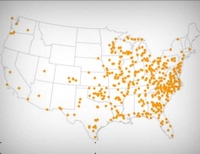Fixing prison-based gerrymandering after the 2010 Census: Massachusetts
50 State Guide, March 2010
- Sections
- Impact at the state level
- Impact at the local level
- Massachusetts law says a prison cell is not a residence
- Other solutions
- Additional resources
Prison-based gerrymandering violates the constitutional principle of "One Person, One Vote." The Supreme Court requires districts to be based on equal population in order to give each resident the same access to government. But a longstanding flaw in the Census counts incarcerated people as residents of the prison location, even though they can’t vote and aren’t a part of the surrounding community.
When legislators claim people incarcerated in their districts are legitimate constituents, they award people who live close to the prison more of a say in government than everybody else.
Impact at the state level:
- Without using prison populations as padding, 5 Massachusetts House districts drawn after the 2000 Censis did not meet constitutional population requirements.
- For example, each House district in Massachusetts should have had 39,682 residents. The 3rd Suffolk District, which claimed the population of the Suffolk Count House of Corrections, however, had only 36,428 actual residents. This means that the actual population of the district was 8.2% smaller than the average district in the state.
- Crediting all of Massachusetts’ incarcerated people to a few locations, far from home, enhances the political clout of the people who live near prisons, while diluting voting power of all other Bay Staters.
Impact at the local level:
- States are not the only political units to grapple with the Census Bureau prison counts that threaten to distort voting rights. Cities, for example, must also draw city council districts based on population. But because these council districts are so much smaller than state legislative districts, a single large prison can have a huge effect.
- When the city of Gardner last updated their districts in 2001, they were faced with the prospect of giving the residents on the eastern side of the city near the state prison extra influence over city affairs, or rejecting the flawed Census counts. The City Council ruled to reject the Census counts because doing otherwise would have given each group of 8 people who live near the prison as much say over city affairs as every group of 10 residents elsewhere in the city.
Massachusetts law says a prison cell is not a residence:
- A legal residence is the place that people choose to be and do not intend to leave; and because prison is not voluntary, it cannot be a residence.
Until 2000, incarcerated Massachusetts residents could vote, and where they could vote was a frequent subject of litigation. In the late 1970s, people in prison were considered to be presumptive residents of their home addresses. Only in rare special situations, could an incarcerated person argue that he intended to remain in prison permanently; but by the early 1980s, even this narrow loophole was removed and all incarcerated voters in the state were required to vote as residents of their pre-incarceration homes.
In Dane v. Board of Registrars of Concord, 374 Mass. 152 (1977), the Supreme Judicial Court reiterated that prisoners are presumptively residents of their home districts and not of the prison district, although it did allow the Concord registrar to accept registrations from prisoners who had shown they had willingly established themselves as residents of the town of Concord. When such a showing was not present, the Supreme Judicial Court upheld the refusal of the Norfolk registrar to register 619 residents of Norfolk prison as residents of the town in Paul Ramos v. Board of Registrars of Voters of Norfolk, 374 Mass. 176 (1978).
Other solutions:
- All Massachusetts municipalities that contain prisons should adopt similar solutions to the city of Gardner, which already bases its districts on actual, not prison populations.
- Ideally, the U.S. Census Bureau would change where it counts incarcerated people. They should be counted as residents of their home — not prison — addresses. There is no time for that in 2010, but Massachusetts should ask the Census Bureau for this change for 2020.
- After the 2010 Census, the state and its local governments should, to the degree possible, count incarcerated people as residents of their home communities for redistricting purposes. Where that is not feasible, incarcerated people should be treated as providing unknown addresses instead of being used to pad the legislative districts that contain prisons.
Additional resources:
- Continually updated information on the current campaign for change in Massachusetts.
- Importing Constituents: Prisoners and Political Clout in Massachusetts, is a district-by-district analysis of prison-based gerrymandering in Massachusetts state legislative districts.
Events
- April 15-17, 2025:
Sarah Staudt, our Director of Policy and Advocacy, will be attending the MacArthur Safety and Justice Challenge Network Meeting from April 15-17 in Chicago. Drop her a line if you’d like to meet up!
Not near you?
Invite us to your city, college or organization.



